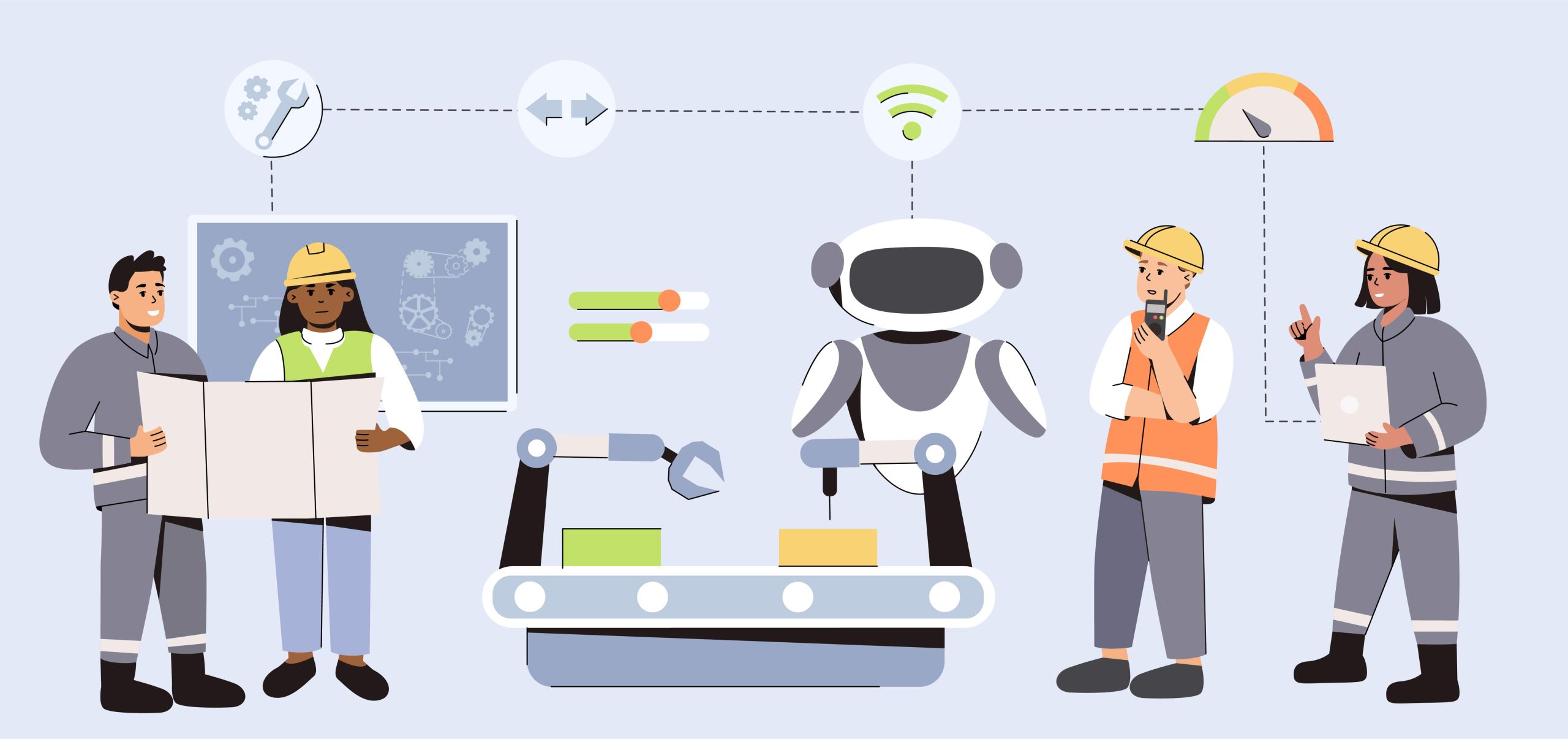- Blog Manufacturing AI Predictive Maintenance




Manufacturing AI Predictive Maintenance
Manufacturing AI Predictive Maintenance – Implementation Guide 2025
What is Manufacturing AI Predictive Maintenance?
Manufacturing AI predictive maintenance uses artificial intelligence to predict equipment failures before they occur, revolutionizing how industrial facilities manage critical assets. Instead of reactive repairs or arbitrary schedules, manufacturers gain proactive intelligence that optimizes maintenance timing and prevents costly downtime.
Modern manufacturing AI predictive maintenance platforms combine IoT sensors with machine learning algorithms, equipment databases, and maintenance management systems. These intelligent systems monitor vibration, temperature, pressure, and performance metrics continuously analyzing patterns to predict failures weeks or months in advance.
Leading manufacturers leverage manufacturing AI predictive maintenance to prevent unexpected shutdowns costing thousands per hour. The technology addresses critical challenges including equipment complexity, rising maintenance costs, and pressure to minimize unplanned downtime while maintaining safety standards.
Key Benefits for Industrial Operations
Dramatic Downtime Reduction
Manufacturing AI predictive maintenance delivers 20-50% reductions in unexpected equipment failures. By predicting issues before they cause breakdowns, facilities schedule maintenance during planned shutdowns, preventing emergency repairs and production losses.
Key advantages include:
1. Early warning alerts weeks before potential failures
2. Scheduled maintenance during optimal timeframes
3. Eliminated costly emergency shutdowns
4. Continuous production capability
Maintenance Cost Optimization
Organizations achieve 10-30% maintenance cost reductions through:
1. Optimized maintenance timing based on actual equipment condition
2. Reduced emergency repair expenses
3. Extended equipment lifespan (20-40% improvement)
4. Efficient spare parts inventory management
5. Better resource allocation across facilities
Production Efficiency Improvements
Manufacturing AI predictive maintenance contributes to 5-15% production efficiency gains through:
1. Increased overall equipment effectiveness (OEE)
2. Reduced production variability
3. Consistent product quality
4. Optimized production scheduling
5. Minimized quality issues from equipment degradation
Safety & Compliance Enhancement
Proactive monitoring identifies potential safety hazards before incidents occur:
1. Safety-critical equipment receives priority attention
2. Environmental release risks are minimized
3. Regulatory compliance improves
4. Personnel safety increases significantly
Energy Efficiency Gains
Systems identify when performance degradation increases energy consumption, enabling interventions that restore optimal efficiency. Manufacturers typically achieve 5-20% energy savings through improved equipment performance.
Real-World Applications
Rotating Equipment Monitoring
Manufacturing AI predictive maintenance excels at monitoring motors, pumps, compressors, and similar machinery. Systems analyze vibration signatures, temperature patterns, and electrical characteristics to identify developing issues like:
1. Bearing wear
2. Shaft misalignment
3. Rotor imbalance
4. Lubrication problems
Early detection enables planned maintenance weeks before failure occurs.
Process Equipment Optimization
For complex industrial processes including heat exchangers, reactors, and distillation columns, manufacturing AI predictive maintenance monitors:
1. Process parameters and efficiency trends
2. Equipment performance degradation
3. Optimal cleaning and calibration timing
4. Component replacement scheduling
Production Line Intelligence
Systems monitor entire production lines, identifying potential bottlenecks and performance issues. Manufacturing AI predictive maintenance analyzes:
1. Equipment interactions across production flows
2. Quality metrics correlated with equipment health
3. Production efficiency optimization opportunities
4. Coordinated maintenance scheduling to minimize impact
Quality Control Integration
By connecting equipment health with product quality metrics, manufacturing AI predictive maintenance identifies when degradation begins impacting specifications. This prevents quality issues, recalls, and customer complaints through timely interventions.
SME Implementation Roadmap
Phase 1: Assessment & Planning (Weeks 1-4)
Start your manufacturing AI predictive maintenance journey by:
Identifying Critical Equipment:
1. Review maintenance records for frequent failures
2. Document costly downtime incidents
3. Prioritize equipment based on production impact
4. Select 5-10 initial monitoring targets
Analyzing Current State:
1. Calculate baseline downtime costs
2. Track existing maintenance expenses
3. Document common failure modes
4. Identify measurable improvement opportunities
Phase 2: Platform Selection (Weeks 5-8)
Choose platforms offering:
1. Easy sensor integration with existing industrial systems.
2. Pre-built analytics for common equipment types.
3. Customizable alerts matching your operational requirements.
4. CMMS integration with maintenance management systems.
5. Scalable pricing aligned with monitoring needs.
Popular SME Options:
1. Siemens MindSphere
2. Microsoft Azure IoT for Manufacturing
3. Augury (specialized for rotating equipment)
4. Uptake
5. C3 AI (for larger SMEs)
Phase 3: Pilot Implementation (Months 3-6)
Sensor Deployment:
1. Install sensors on critical equipment
2. Establish network connectivity
3. Configure data collection parameters
4. Test sensor reliability and data quality
System Configuration:
1. Set baseline operating parameters
2. Configure alert thresholds
3. Integrate with maintenance workflows
4. Train maintenance teams on system usage
Validation & Refinement:
1. Monitor prediction accuracy
2. Adjust alert sensitivities
3. Document early successes
4. Gather team feedback
Phase 4: Expansion & Optimization (Months 7-12)
Once pilot proves successful:
1. Expand monitoring to additional equipment
2. Refine analytics based on operational experience
3. Optimize maintenance scheduling processes
4. Measure and document ROI
5. Scale across additional production areas
Common Challenges & Solutions
Data Quality & Sensor Reliability
Select industrial-grade sensors designed for harsh environments. Implement regular sensor maintenance schedules and establish data validation procedures to ensure consistent quality.
Integration Complexity
Choose platforms with pre-built connectors for your existing systems. Implement phased integration starting with critical equipment before expanding network wide.
False Positives & Alert Fatigue
Start with conservative alert thresholds and refine based on operational experience. Establish validation procedures and provide clear escalation guidelines for maintenance teams.
Maintenance Team Adoption
Involve maintenance personnel early in planning. Provide comprehensive training emphasizing how manufacturing AI predictive maintenance enhances rather than replaces their expertise. Celebrate early wins visibly.
Cost Justification
Calculate comprehensive ROI including downtime prevention, maintenance cost reduction, equipment life extension, and energy savings. Track metrics consistently and report results regularly to stakeholders.
Manufacturing AI predictive maintenance represents a fundamental shift in equipment management strategy. By predicting failures before they occur and optimizing maintenance timing, these intelligent systems deliver measurable improvements in reliability, costs, and operational efficiency.
For manufacturers ready to implement predictive maintenance, success requires focusing on clear operational objectives rather than technology showcase. Start with critical equipment, choose platforms aligned with your technical capabilities, and build comprehensive monitoring gradually as experience develops.
The competitive advantages are substantial for organizations acting decisively. Whether you’re in discrete manufacturing, process industries, or specialty production, manufacturing AI predictive maintenance offers proven benefits in downtime reduction, cost optimization, and production efficiency.
Ready to transform your maintenance strategy?
Contact Incepteo Group to explore how our AI solutions can enhance your manufacturing operations while maintaining the safety and reliability standards your industry demands.
FAQs
What types of equipment benefit most from manufacturing AI predictive maintenance?
Rotating equipment (motors, pumps, compressors), process equipment (heat exchangers, reactors), production line machinery, and safety-critical systems benefit most.
Equipment with measurable condition indicators like vibration, temperature, or electrical signatures are ideal candidates for predictive monitoring.
Can small manufacturers implement manufacturing AI predictive maintenance?
Absolutely. Cloud-based platforms now make manufacturing AI predictive maintenance accessible for facilities of all sizes. Start with critical equipment monitoring and expand as you demonstrate value. Many solutions offer scalable pricing that grows with your needs.
How long before we see ROI from manufacturing AI predictive maintenance?
Most organizations see measurable benefits within 6-12 months. Early wins often include preventing even one major failure, which can justify the entire investment. Comprehensive ROI including cost reductions and efficiency gains typically materializes within 12-24 months.
Does manufacturing AI predictive maintenance replace maintenance teams?
No. Manufacturing AI predictive maintenance enhances maintenance capabilities by providing advance warning and optimization insights. Skilled technicians remain essential for executing maintenance, troubleshooting complex issues, and making critical operational decisions.
What’s the difference between predictive and preventive maintenance?
Preventive maintenance follows fixed schedules regardless of equipment condition. Manufacturing AI predictive maintenance uses real-time data and AI analysis to predict optimal maintenance timing based on actual equipment health, preventing unnecessary maintenance while catching issues before failures occur.
Share this:
Recent Posts
By Sector

How Can Incepteo Help You?


Quick Links
AI SERVICES
2024 © All rights reserved by Incepteo